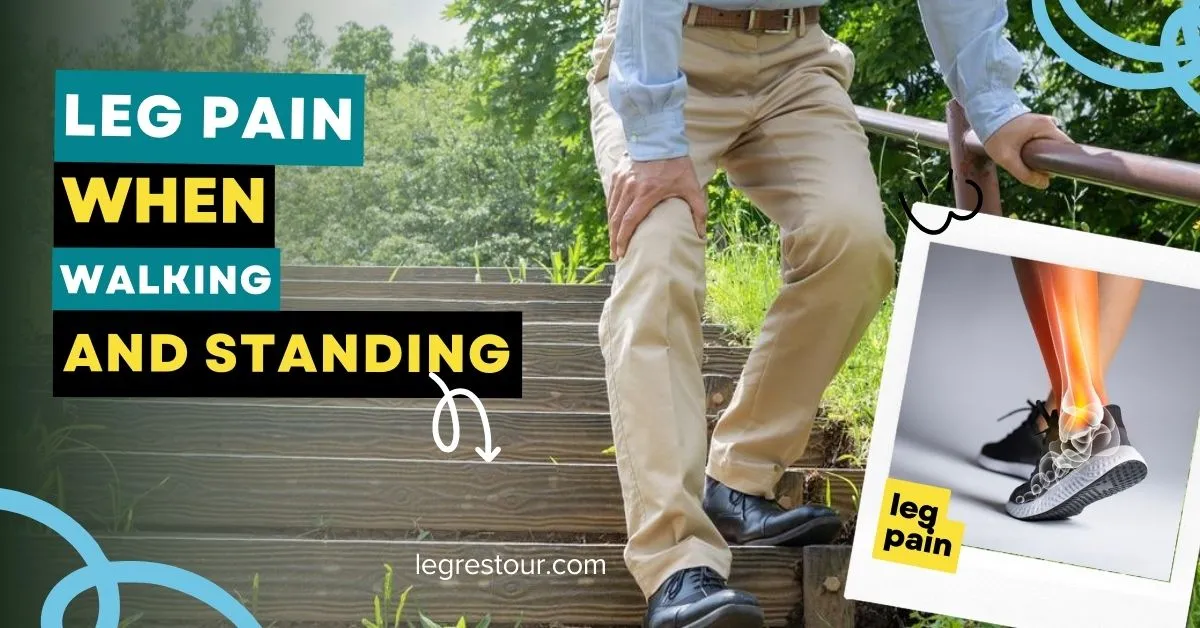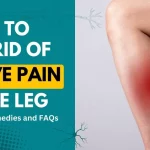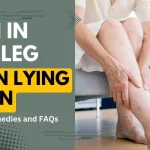Experiencing leg pain when walking or standing is a common problem that can significantly impact daily life. This type of leg pain has many potential causes, from simple muscle strains to serious medical conditions. Identifying the root cause is key to finding the right treatment and relief. This article explores the various reasons you may have leg pain when walking or standing, effective remedies and self-care strategies, and answers some frequently asked questions about this troublesome symptom.
Causes of Leg Pain When Walking and Standing
There are a number of possible causes for leg pain that occurs during walking or standing. Here are some of the most common:
Muscle strain
Straining or overworking the muscles in the legs through exercise, sports, or other strenuous activity can lead to pain. Typical areas affected are the calves, thighs, and hamstrings.
Peripheral artery disease (PAD)
PAD causes narrowing of the peripheral arteries, reducing blood flow to the legs. Pain occurs when walking or standing due to lack of oxygen delivery. PAD usually affects the calves.
Lumbar spinal stenosis
This condition causes narrowing of the spinal canal in the lower back, pinching the nerves that run down the legs. Pain occurs with walking and standing.
Arthritis
Osteoarthritis, rheumatoid arthritis, and other forms of arthritis can affect the knee, hip, ankle, and foot joints. The inflammation and joint damage leads to pain that worsens with walking and activity.
Achilles tendonitis
Inflammation of the Achilles tendon at the back of the ankle causes pain when walking or pushing off on the foot.
Peripheral neuropathy
Nerve damage in the legs from diabetes, chemotherapy, or other causes induces burning, tingling, or shooting pains down the legs.
Baker’s cyst
This fluid-filled swelling behind the knee can cause pain, tightness, and discomfort that increases with activity.
Plantar fasciitis
Inflammation where the plantar fascia tendon inserts into the heel bone creates intense heel pain when standing and first steps after rest.
Sciatica
Compression or irritation of the sciatic nerve can radiate pain from the back, down the leg to the knee, calf or foot. Walking tends to aggravate it.
Shin splints
Pain along the shin bone from overuse or stress fractures results in uncomfortable shin pain when walking and running.
Blood clots
A blood clot in a deep vein (deep vein thrombosis) can cause leg swelling, pain, and tenderness that worsens with standing or movement.
There are also some less common potential causes to be aware of:
- Compartment syndrome – Increased pressure in the leg muscles reduces blood flow and causes pain.
- Stress fractures – Small cracks in the bones of the leg from overuse causes pain when standing or walking.
- Osteosarcoma – A rare type of bone cancer that can occur in the legs.
- Paget’s disease – Excessive bone breakdown and regrowth causes bone pain and deformity.
- Polymyalgia rheumatica – Inflammation of muscle tissue leads to stiff, painful legs.
Getting an accurate diagnosis from your doctor is important to determine the cause and suitable treatments. Depending on the severity, diagnostic tests like x-rays, CT scans, MRIs, EMG, nerve conduction studies, ultrasound, or angiogram may be undertaken. Blood tests can also help rule out inflammatory or autoimmune conditions.
Home Remedies and Self-Care Strategies
There are a variety of self-care remedies and tips that may help alleviate leg pain associated with walking or standing:
Rest
Take a break from any activities that aggravate the pain to allow time for recovery.
Ice
Applying an ice pack wrapped in a towel to painful legs for 15-20 minutes can reduce swelling and inflammation.
Compression
Wrapping the leg with an elastic bandage or wearing compression stockings improves circulation and provides support.
Elevation
Lie down and raise sore legs above the level of the heart to encourage blood flow out of the legs.
Gentle stretching
Light stretches that target the calves, hamstrings and front and back of the thigh can limber up stiff, achy muscles.
Exercise
Low-impact activities like walking, cycling, or swimming can build strength to support the legs without added stress.
Lose weight
For overweight individuals, losing excess weight reduces stress on the joints, feet, and legs during activity.
Proper footwear
Wearing supportive, well-cushioned shoes is vital, especially for plantar fasciitis and arthritis sufferers.
Massage
Gentle massage increases circulation and mobility and helps sore muscles recover. Focus on the calves, thighs, feet, and back.
Lifestyle changes
Stop smoking, manage chronic health conditions, and control blood sugar levels to improve circulation in the legs.
Medical Treatments for Leg Pain
For moderate to severe leg pain, it is important to see a doctor for a medical evaluation. The appropriate treatments will depend on the diagnosed cause. Some of the medical treatment options for leg pain with walking or standing include:
Medications
Prescription anti-inflammatory drugs, analgesics, statins, or antibiotics (for infections).
Injections
Steroid injections can reduce inflammation from arthritis, bursitis or tendonitis. Nerve blocks may calm sciatic and neuropathy pain.
Compression stockings
Prescription gradient compression stockings promote circulation in PAD patients.
PT/Rehabilitation
Stretching, strengthening exercises, or gait training may be prescribed.
Orthotics
Inserts or braces can provide arch support, heels pads or cushioning for plantar fasciitis.
Surgery
Procedures like angioplasty for PAD, knee or hip replacement for arthritis, or bone spur removal may be warranted.
Alternative medicine
Options like acupuncture, massage therapy, or chiropractic care may complement conventional treatment.
Lifestyle Measures for Managing Leg Pain
Making certain lifestyle adjustments and adopting healthier habits can often help minimize recurrent leg pain with walking and standing:
- Maintain a healthy weight to avoid extra pressure on the legs.
- Quit smoking to optimize circulation and heal faster from injuries.
- Limit alcohol intake which can contribute to neuropathy and balance issues.
- Manage diabetes and control blood sugar to prevent nerve damage in the legs.
- Wear properly fitted, supportive footwear and replace shoes frequently.
- Rest immediately when you feel leg pain and avoid pushing through it.
- Stretch before and after exercise to increase flexibility.
- Build physical activity slowly with low-impact options like swimming or cycling.
- Use proper posture and body mechanics to avoid further injury.
- Apply ice and elevate legs to reduce pain and swelling after activity.
- Listen to your body’s signals and allow adequate rest between workouts.
In summary, leg pain that occurs when walking or standing has numerous potential causes. Getting an accurate diagnosis is key, as treatments will vary based on the condition. Typical remedies include rest, ice, compression, medication, injections, orthotics, rehabilitation exercises, and sometimes surgery. Making lifestyle changes like losing weight, quitting smoking, and wearing appropriate footwear can also make a difference in managing symptoms. Addressing any leg pain that limits normal activity promptly leads to the best outcome.
It’s important for you : Leg Pain Without Swelling or Redness
Frequently Asked Questions
1. Is leg pain when walking serious?
Leg pain with walking is usually not an emergency, but can be serious depending on the cause. Mild muscle soreness will resolve while pain from spinal stenosis, PAD, or a stress fracture needs prompt medical care. Evaluate your symptoms and see a doctor if pain persists.
2. What helps ease pain in legs when walking?
Applying ice packs, massaging sore muscles, elevating the legs, taking anti-inflammatories, and wearing compression stockings can help alleviate leg pain when walking. Stretching or light exercise may also provide some relief.
3. Can peripheral artery disease cause leg pain when walking?
Yes, peripheral artery disease commonly causes cramping, fatigue, or heaviness in the leg muscles when walking. PAD is caused by atherosclerosis which blocks blood flow to the legs.
4. Should I avoid walking with arthritis knee pain?
Walking is actually beneficial for arthritic knee pain, with some caveats. Use supportive footwear on flat surfaces and start slow. Avoid overdoing walks when knees are very inflamed. Low-impact exercise helps lubricate knee joints.
5. Does back or sciatica pain cause leg pain when walking?
Back conditions like spinal stenosis, herniated discs, scoliosis, or sciatica can cause referred pain down the legs when walking. Nerve compression in the spine can radiate pain into the buttocks, thighs, calves or feet.
6. How can I tell if leg pain is from lack of circulation versus nerve damage?
Blocked circulation causes cramping or fatigue in calves or thighs while walking which resolves with rest. Nerve pain usually produces numbness, tingling, burning or shooting pain which persists despite rest.
7. Are compression socks helpful for leg pain?
Yes, compression socks can aid leg pain by improving circulation and reducing swelling. They also provide support and help leg muscles work more efficiently. Good for chronic venous insufficiency, pregnancy, travel, PAD and fatigue.
8. How long does it take for leg pain when walking to go away?
Duration depends on the cause. Mild strains may resolve in a few days with rest while spinal stenosis or PAD pain requires ongoing treatment. See your doctor if pain lasts over 1 week or limits daily activities.



